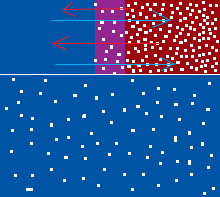3
The fresh melt water (which floats above the saltier water below) starts mixing
with the water of the Gulf Stream (which floats above the cooler water beneath
it).
4
Melt water mixes with Gulf Stream water, and is cooled by the Arctic temperatures,
until it resembles the “normal” water in the Arctic Ocean, neither
saltier nor particularly warmer. Thus there is no incentive for the "waterfall
effect", and the thermohaline circulation slows down.
5
In this way the part of the Gulf Stream located in the Northern Atlantic may
be weakened. The consequences of this are still unknown, but a drop in temperature
in Western Europe is probably to be expected.
The
physical processes involved are of course a lot more complex
than what we have presented here. For more detailed accounts, please see the
links section.
Since
the 1960s, the sub-polar seas bordering the North Atlantic have become noticeably
less salty, especially in the last decade. This has resulted in a freshening
of the deep ocean in the North Atlantic. In the past, this has disrupted the
Gulf Stream and caused abrupt climate changes (
EEA,
2004).


